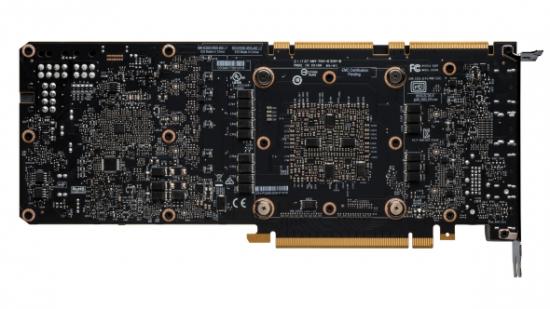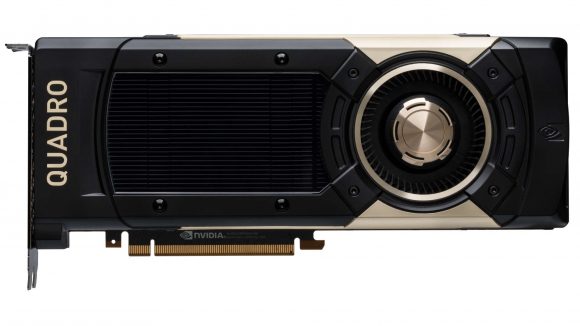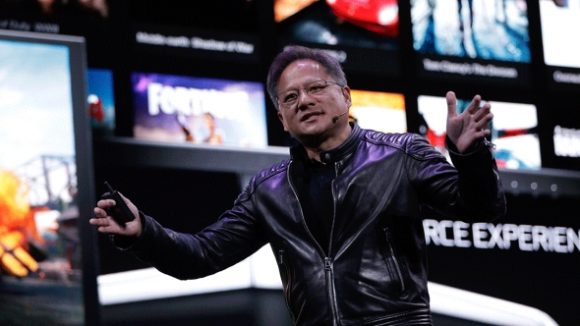Nvidia was testing some monstrous new PCIe graphics cards late last year, potentially from the Nvidia Ampere generation, if the recently unearthed Geekbench database entries are to be believed. The largest of the two GPUs in question supposedly sports more than a 60% increase in SMs compared with the top graphics silicon of the Nvidia Turing architecture generation, and the smaller one still over-shadows anything we’ve seen from the green team in recent years. Even the server-side V100 GPUs…
But the odd thing is that these results tipped up in October last year and have only surfaced over the weekend; nothing else has been even remotely tipped about the two GPUs which must still be being tested. That and they’ve been tested in some relatively low-rent system configurations too. The two beefy GPUs, henceforth known as Big and Little, were being run in a basic Z370 Coffee Lake motherboard with an 8700K and dual channel memory.
I’m not particularly knowledgeable about pre-release in-house graphics card testing, but if these were the next-gen Nvidia Ampere Quadro graphics cards people have been suggesting they are I would have thought they’d be run in a HEDT environment with quad-channel memory.
But these engineering samples are being run at low clock speeds of 1.11GHz and 1.01GHz, way below what the current generation of professional Nvidia graphics cards are released running at. So maybe this was some sort of power on test with some light workloads run through them to make sure the silicon was running and capable of at least sitting up straight in the Windows environment.
Nvidia Ampere GPU specifications
| Big | Little | Quadro RTX 8000 | Titan RTX | |
| SMs | 118 | 108 | 72 | 72 |
| CUDA Cores | 7,552* | 6,912* | 4,608 | 4,608 |
| Memory | 24GB | 48GB | 48GB | 24GB |
| Boost clock | 1.11GHz | 1.01GHz | 1,770MHz | 1,770MHz |
| OpenCL score | 184,096 | 141,654 | 130,465 | 131,974 |
*Very, very unconfirmed… see below
In terms of spec, Big has 24GB of video memory with 118 listed compute units (CUs). That phraseology is analogous to Nvidia’s Streaming Multiprocessors (SMs), and if Ampere (or Hopper, or whatever Nvidia ends up calling this next-gen architecture) works with the same core-to-SM ratio then we’re looking at 7,552 CUDA cores.
The difficulty is that Geekbench may not be reporting the number of CUs correctly, and Nvidia could well be switching around the way it fills out the SMs in its next-gen GPUs. There have been rumours that the green team is doubling up on floating point units in its new architecture, while leaving the number of integer units the same. So where you’d end up with 7,552 INT32 units inside the Big GPU, you’d then get a total of 15,104 FP32 units to make nice with the floating point calculations graphics cards spend a lot of their time processing.
Little, by contrast is a 48GB (Geekbench reports 46.8GB, but that’s just weird) card with 108 compute units. Maths then states we’re looking at either 6,912 CUDA cores, or 13,824 FP32 units and half that again in INT32.
And if you want to talk floating point operations you’d be looking at Big being a 33.5 TFLOPS GPU (FP32 units x 2 x 1.11GHz) and Little being a 27.9 TFLOPS chip, at those low-rent clock speeds anyways. At release frequencies they could be much higher.
But still, Ampere specs and design are just based in rumour so far, so take all that with the requisite level of sodium ingestion. I’m not sure whether the fact that the OpenCL scores are that much higher than existing Nvidia silicon really points to the doubling of FP32 units in the next-gen GPUs or not.
These two listings do at least tie in with one of the previous rumours – the suggestion that the GA100 silicon, the top chip in the new Nvidia Ampere generation, would house up to 128 SMs in its full-fat GPU makeup. Big and Little would then be cut down versions of this same silicon.
There is currently the expectation that, so long as it goes ahead, the Nvidia Graphics Technology Conference in San Jose this month will kick off with a Jen-Hsun Huang keynote introducing its next generation of graphics architecture, with the focus on compute rather than actual gaming workloads.
We’d then expect to see more about what this pair of beefy GPUs actually look like in the flesh, but that wouldn’t necessarily follow that’s what our gaming cards would end up like. It’s looking more and more like both Nvidia and AMD are bifurcating their GPU architectures, with one for AI and server-side compute and another for purestrain gaming. And Nvidia’s unlikely to ship a new dedicated GeForce generation until towards the end of the year at the earliest.
Though if AMD does release its Big Navi card sooner rather than later maybe we’ll see a 7nm Nvidia GPU response…


